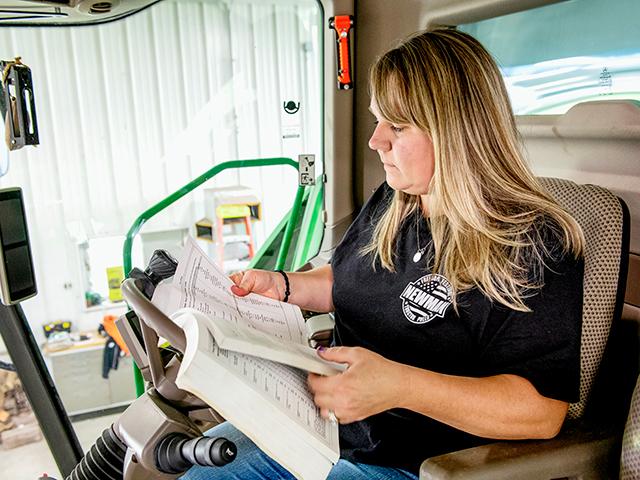Conservation Plan Reduces Erosion and Increases Soil Organic Matter
Never Allow a Gully
Don Veatch's interest in stewarding the land began when he was an elementary school student, and his mother helped him compose a winning personal-point-of-view conservation district essay. Veatch's premise opposed a proposal that would have flooded his family's central-Kentucky property on the site of a lake that had not existed since prehistoric times.
"That's when I realized people could change things through their own actions," he explains. The proposed dam project never materialized, and Veatch and his family still farm the hard-to-manage heavy soils of the ancient lake bottom, locally dubbed "The Lagoon," near Lebanon -- about an hour's drive southeast of Louisville.
"What I learned as a child during that public debate and my father's oft-quoted rule: 'Never allow a gully on the farm' has guided me throughout my farming career," he explains.
Today, Don and his son, Josh, farm 600 to 700 acres in a no-till corn, soybean and wheat rotation, and manage another 300 acres of grass for up to 150 to 200 cattle, including their own commercial cow herd of 40 mamas. In addition, daughter, Kelsey Livers, has developed a "subscription-based" freezer-beef business featuring 100% on-farm finished cuts.
Veatch Farms was recently awarded the Kentucky Leopold Conservation Award for 2023, given in honor of renowned conservationist Aldo Leopold, in recognition of extraordinary achievements in voluntary conservation and management of natural resources.
SWITCH TO NO-TILL
Fields here quickly become soggy in rainy periods, then become severely dry shortly after the rains stop. As a result, The Veatches adopted no-till in 1992 on double-crop soybeans behind wheat.
Veatch says the experience, which was in response to an extended drought, worked so well, they quickly adopted no-till across all their cropland. They soon began noticing fields were much easier to farm.
P[L1] D[0x0] M[300x250] OOP[F] ADUNIT[] T[]
"Heavy rains infiltrate into the soil more quickly with field residue and crop stubble on the soil surface," he explains. "When the rains stop, that same residue continues to protect the topsoil from wind and water erosion, and helps maintain soil-moisture levels."
COVER IT UP
To further enhance soil health, the Veatches adopted cover crops on all of their fields 10 years ago to maintain living plant roots in the soil as long as possible throughout the growing season. The practice boosts soil microbiology in the root zone and shields the soil from wind and water erosion. Over time, cover crops also help increase soil organic matter.
"We began to control erosion by no-tilling, but it wasn't until we included cover crops in our rotation that we saw improvements in organic matter (OM)," Veatch says. "Before cover crops, our fields tested in the 2% range for OM, but now we have soils testing over 3% in some fields, and the farm OM averages from one-half to one percentage point over where we began."
The cover crops also reduced soil lost to runoff from the farm into a creek that bisects the property. "Using continuous no-till stopped major erosion on our farm, but it wasn't until the cover crops that we stopped seeing even small gullies," Veatch explains. "The covers also help us scavenge any excess nutrients that might find their way into the waterways."
He says he's experimented with several cover crops but typically returns to winter wheat to protect his soils.
"When you're trying to establish a cover behind cash crops harvested in the fall, it's difficult to get enough growth with many covers before the first freeze kills them," he explains. "Winter wheat, planted in the fall, works no matter what, and on part of our fields, it serves as a cash crop in our rotation."
Veatch says yields over the past three years have averaged 90 to 100 bushels per acre (bpa) for soft red winter wheat; 55 for double-crop soybeans; 65 to 70 for full-season soybeans; and roughly 200-plus for corn.
Another prime conservation -- and productivity practice -- displayed at Veatch Farms is managed rotation. Six pasture paddocks divided by electric fence containing round concrete spring-fed water tanks provide fresh grazing and water for the cattle.
They rotate the herd to a different paddock roughly every month. This method provides forage from March through August, before the cattle are given access to the entire pasture through November. Hay produced on adjacent pastures fills the gap for winter feeding.
To further lessen the ecological footprint of the cattle operation, the herd is excluded from the riparian areas of the farm's ponds and creeks, and restricted from timberland, watering only at the concrete watering points.
IMPORTANCE OF TREES
Veatch sees trees as both a renewable resource and conservation tool. He's planted timber along the curves of his farm's creeks to stabilize the soil and reduce flood damage. This timber complements the wide grass cover buffer strips he's established to control erosion near natural drainages.
Existing timber on the farm is treated like a crop, with timber-stand-improvement practices limiting the growth of invasive species, allowing desirables such as oak, walnut and maple trees to share a larger portion of the forest canopy.
Portions of the property's timber, as well as part of the grasslands, are enrolled in USDA's Conservation Stewardship Program to create habitat for wildlife, birds and pollinator insects.
CONSERVATION OUTREACH
The Veatches share their story of agriculture and land stewardship with their freezer-beef customers and by hosting field days. Veatch, who credits his conservation ethic to that long-ago grade-school essay, has been active with his local conservation district board since 1999. In a "full-circle" experience last school year, his granddaughter, Karli Veatch, wrote one of the winning essays in the district's contest.
[PF_1223]
(c) Copyright 2023 DTN, LLC. All rights reserved.




